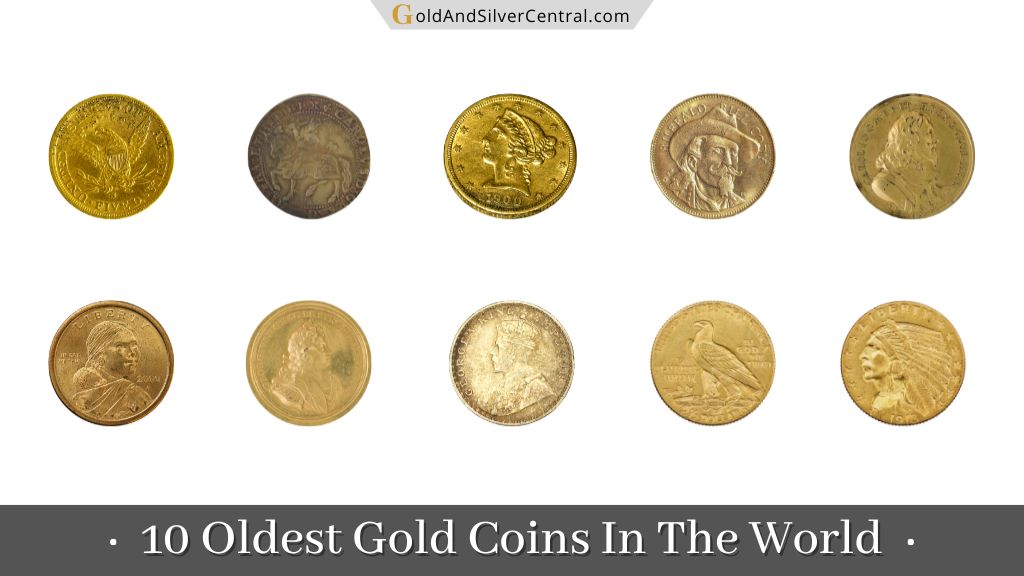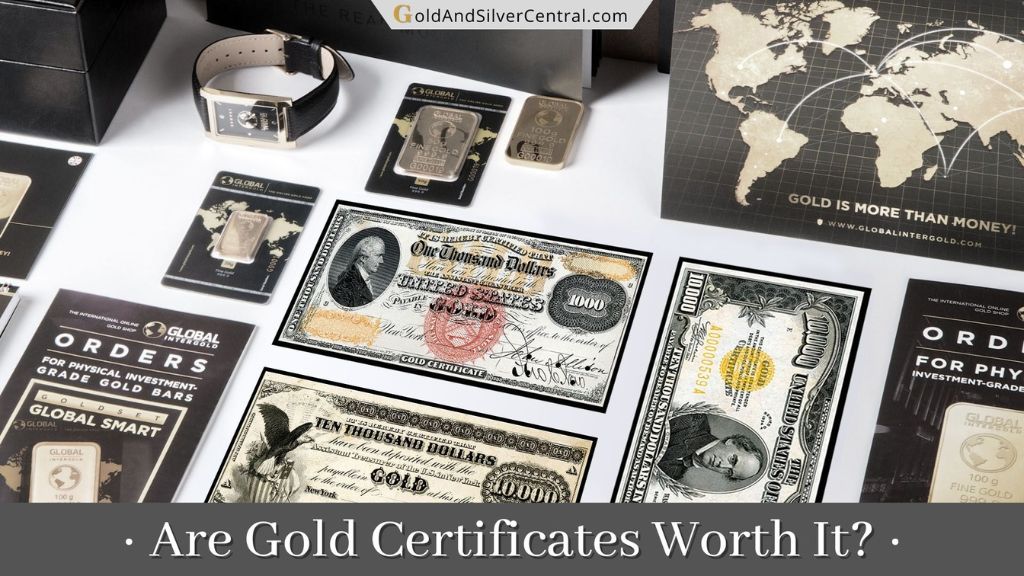Ever wondered:
- What was the first coin ever made?
- What are the oldest gold coins in the world?
Let’s face it, this precious yellow metal has been around since forever, used as the ultimate status symbol, showing off who’s got the power and the wealth.
On top of that, it has been historically used as a currency, allowing ancient people to buy and sell things – just like how we use our fiat money now.
From that mysterious Lydian Lion Trite from way back in the 6th century BCE to that showstopper Venetian Ducat from the 13th century CE, you’re about to get a glimpse into how the ancient world rolled when it came to cold hard cash.
So, whether you’re trying to level up your coin collection or just super curious about the OG money, you’re in for a treat.
Buckle up as we hop into our time machine and reveal the top 9 oldest gold coins that ruled the ancient world.
Without further ado, let’s begin our journey back in time!
9. Venetian Ducat
As its name implies, this relic originated from Venice.
From the 13th to the 18th century, this island city was rolling in the dough with this iconic gold coin.
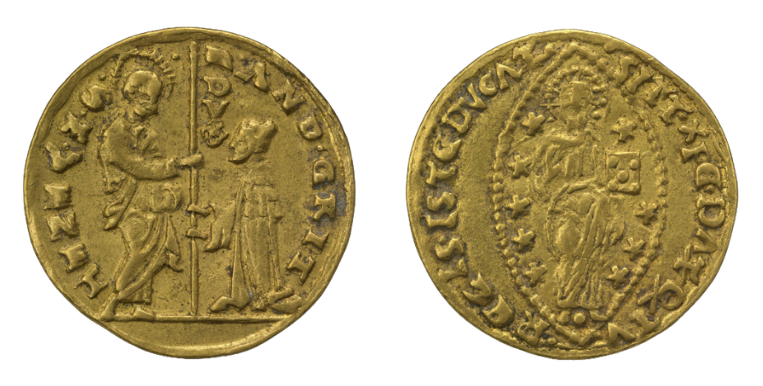
The Ducat wasn’t just a currency; it was a symbol of the booming era when Venice ruled the seas and was the place to be for trade and culture.
When it comes to design, this yellow coin is pure art.
On one side, you’d see the doge (kind of like the president of this city back then) and flip it over, and there’s St. Mark, Venice’s number one patron saint, hanging out with an angel.
Talk about mixing politics and spirituality on a single coin!
In any case this coin was a big deal because its weight and purity were as reliable as they come.
When you handed over a Ducat in some medieval marketplace, everyone knew they were getting the real deal. No wonder it was the go-to coin for traders all over, boosting Venice’s rep as the hotspot for global trade.
So yeah, the Ducat was the emblem of Venice’s power, blessings, and its killer spot in the world trade game.
Fun fact: Venice was like the OG of connecting the East and West and this coin was the golden ticket that made it all happen!
8. Abbasid Dinar
This was the coin during the grand times of the Abbasid Caliphate from 750 to 1258 CE.
Imagine having one single coin that pretty much everybody trusts across a massive empire stretching from North Africa to Central Asia. Yep, that was the Abbasid Dinar for you!
Now, design-wise, this coin kept things pretty straightforward. No fancy images, just sleek Arabic calligraphy.
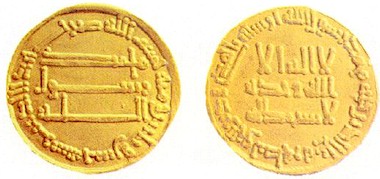
Why? Islamic tradition prefers to steer clear of depicting living beings on things like coins.
What you would find, though, are Arabic inscriptions, including the Islamic declaration of faith and the name of the big boss — the caliph.
What made the Abbasid Dinar super cool was its reach.
You could use it for trade not just within the empire but even beyond. Being smack in the middle of major trade routes certainly gave it an edge.
Beyond its economic role, this coin had some deep meanings.
The inscriptions on it weren’t just decorative — they reflected the empire’s religious identity and the caliphs’ commitment to Islamic values.
Every time someone held an Abbasid Dinar, they were basically holding a piece of the empire’s pride and faith.
For anyone with a love for history or coin collecting, these Dinars are like the holy grail. They’re not just coins; they’re stories, symbols, and a window into a glorious era.
7. Umayyad Dinar
So, picture this: the Umayyad Caliphate, booming from 661 to 750 CE, decided they needed a coin to really make a mark.
Enter the Umayyad Dinar! Not only was it a stellar coin, but it was also one of the earliest Islamic gold coins.

This shiny relic wasn’t just shiny; it was a big statement of the caliphate’s power and its booming pockets.
These Dinars were pretty consistent, weighing in at about 4.25 grams.
And talk about minimalist design goals: both sides had Arabic inscriptions, including the Islamic shout-out of faith and the name of the reigning caliph.
No images, though. In line with Islamic tradition, they liked to keep their coins living and being free.
Now, this Dinar wasn’t just another coin in the collection; it was a game-changer.
It set the gold standard (pun totally intended) for the vast Islamic Empire, making trade smoother. Its widespread use played a huge role in keeping the empire’s economy steady and growing.
6. Byzantine Solidus
Here’s another interesting story story:
It’s the early 4th century CE, and Emperor Constantine I is ruling the roost in the Byzantine Empire. He decides to roll out the Solidus, making it the go-to gold coin.
This wasn’t just any coin – it was the hallmark of stability and a symbol of “We’re in charge” for the empire.
Now, this wasn’t some hastily made piece of metal. The Solidus was a gorgeous, consistent-weight coin (around 4.5 grams of shiny gold!).
One side showcased the emperor, looking all majestic and powerful, while the flip side often featured none other than Jesus Christ himself, highlighting the empire’s tight-knit relationship with Christianity.

However, keep in mind that there are different Solidus coins with different emperors and symbolic images.
For example, there is Solidus of Constantine the Great, Solidus of Theodosius II, Solidus of Constantius II, and Jesus was not on most coins that came later.
Anyway, the Byzantine Solidus coin was the real MVP when it came to the empire’s monetary system.
Its reputation for consistency made it a hit among traders everywhere – sort of like a credit card everyone trusted. This made trade smoother and placed the Byzantine Empire on the map as a major trade influencers.
Given the empire’s prime spot between Europe and Asia, the Solidus didn’t just stay local.
It became a hot favorite in international trade, making the Byzantine Empire the cool kids in the global trade club.
Here’s the kicker:
The Solidus was so iconic that it stayed relevant for nearly a thousand years. That’s longer than most empires themselves!
Even after the Byzantines clocked out in 1453, this coin was still in high demand, influencing European currency for years to come.
5. Gupta Dinara
Between the 4th and 6th centuries CE, the Gupta dynasty was ruling the roost in ancient India.
These people were minting the Gupta Dinara, which is basically the superstar of ancient Indian coins.
These coins are like tiny gold nuggets of history, telling tales of the empire’s riches and their love for artsy things.
The Gupta Dinara was roughly 8 grams, with a super detailed portrait of either a Gupta king or queen. You can tell they’re all royal and majestic from the way they’re decked out.
Flip the coin, and you’ve got some sacred symbols, maybe a deity or a special animal, giving a nod to their tight bond with Hinduism and other spiritual vibes.

For example:
The obverse of this coin here we see the king, standing facing left, in salwar and wearing necklace, who holds a long bow in his left hand and arrow in his right; and on the reverse we see the Goddess Lakshmi seated on a lotus in padmasana facing front.
These Dinaras weren’t just for buying stuff.
They were a big deal. They’re like the ancient version of putting your face on the cover of a magazine.
Everyone using these coins knew about the Gupta’s power, their love for art, and how deeply religious they were.
You’ve probably heard people calling the Gupta period the “Golden Age” of ancient India because at the time it was great economy, artists getting their groove on, and loads of discoveries and innovations.
And these coins?
They were everywhere, helping the Gupta’s trade game go strong, not just in India but even with places across the sea.
4. Roman Aureus
If coins could strut, this one would be rocking the runway of ancient Rome. Think of the Roman Aureus as the Rolls Royce of coins during the Roman era.
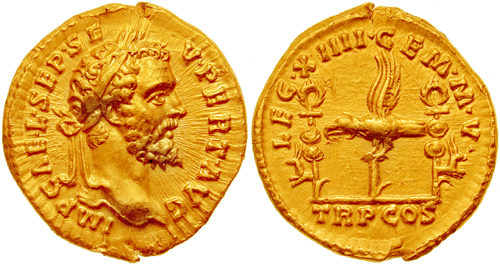
It was a shiny gold coin, weighing around 7.3 grams, with a crisp imprint of the current Roman emperor on one side.
This wasn’t just about showing off the emperor’s good side; it was all about flexing their divine swag and supreme power.
Flip that coin over, and you’d often see cool stories or achievements, like mythological tales or major wins for the empire.
Now, back in the Roman Republic days, gold coins were like unicorns, they’re pretty rare. Most people dealt with bronze or silver coins for their daily deals.
But then, late in the 1st century BCE, the Aureus made its grand entry. Suddenly, the shiny yellow metal was the in-thing, especially for big deals or fancy state expenses.
It wasn’t just about spending power; the Aureus was pure propaganda. Through it, emperors showed off their might and divine connections and told everyone, “We’re the best!”
Having the Aureus around did wonders for the Roman economy.
Imagine a coin that everyone trusted – from your next-door neighbor in Rome to that trader from a far-off land. That’s the kind of street cred this shiny relic had.
Fast forward a bit:
Though the Aureus got replaced by another flashy coin (the Byzantine solidus) in the 4th century CE, its legend lived on and even influenced how coins were made later on.
3. Macedonian Stater
This one is one of the earliest gold coins. For context, let’s teleport back into the 4th century BCE.
King Philip II of Macedon is ruling the scene, and he’s got big plans.
And how does he fund these epic military adventures? The Macedonian Stater – basically the MVP of ancient gold coins.
This relic features a detailed portrait of the Greek god Apollo, looking all regal with a laurel wreath on his head. That wreath? It’s all about victory and major respect.
Flip that coin, and you’ve got a quadriga, which is just a fancy name for a chariot with four horses. It’s like the Ferrari of ancient times, showing off the might of the Macedonian army.
Now, King Philip II wasn’t just using this coin to buy bread at the market.
It was the backbone of his ambitious plans, funding armies, expanding territories, and making Macedon a big name in the trade.
But here’s the cool part: this coin wasn’t just about money.
It was a billboard promoting Greek culture. So, as Macedon grew in size and power, this gold piece became a traveling ambassador, spreading the Greek vibe everywhere it went.
Now, fast forward a bit.
King Philip II meets a tragic end, and guess who steps up? His son, Alexander the Great. You’ve probably heard of him; he was kind of a big deal.
We all know that he took the empire to a whole new level, conquering places from Asia to Africa.
And what happened to the Stater?
Still in play, but with a twist. Alexander’s face starts showing up, giving Apollo a bit of a break.
2. Persian Daric
This is the superstar of ancient gold coins from the Achaemenid Empire.
This empire was the real deal – we’re talking a massive territory from the eastern Mediterranean all the way to the Indus River!
So, about the Persian Daric:
Imagine a super shiny gold piece with an image of the kin, not any specific one, just a cool idealized version, doing this epic pose, either kneeling or running, and wielding a bow and spear.
Flip it, and you’ll see this unique sunken punch impression, giving it that “I’m special” look.
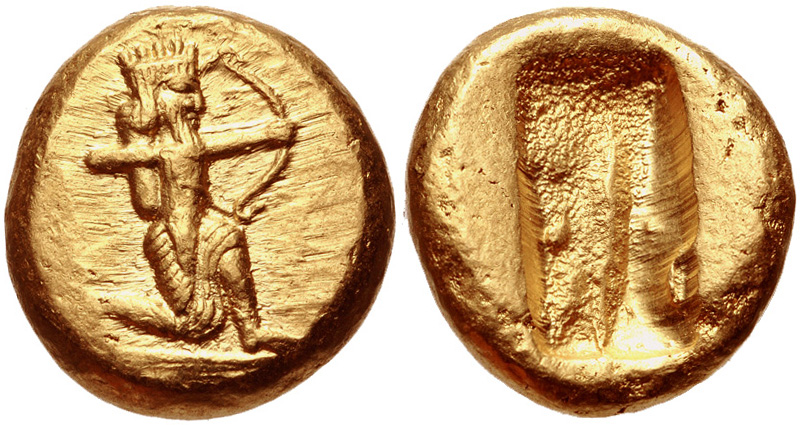
Now, why was the Daric so game-changing?
This coin was all about keeping things consistent – in weight and purity.
Basically, it was the ancient world’s trusty currency for trading. So, if you were in the empire, or even outside it, this was the go-to coin to make those transactions smooth.
And speaking of influence, the Daric was the influencer of its time.
As the Achaemenid Empire became the empire to watch, this gold coin became a symbol of their power, making waves all across the ancient world.
However, like all epic sagas, there was an endgame.
Alexander the Great, that young conqueror, rolls in during the 4th century BCE and the Achaemenid Empire becomes history.
But the Persian Daric?
Its legendary status lives on. Future empires and kingdoms saw how amazing its concept was and adopted the idea for their own.
1. Gold Stater of Croesus
This one is one of the oldest gold coin in the world that forever changed the precious metal game.
We’re heading back to the 6th century BCE with the reign of King Croesus of Lydia (in present-day Turkey) who ushered in a new era when he ordered struck the first gold coins in 550 BC.
So if you wondered what was the first gold coin ever minted, then it’s the Lydian Lion Trite.

Ever heard of the term “rich as Croesus”? Well, this king and his kingdom were onto something big with coins!
They’ve introduced the Gold Stater of Croesus, and this wasn’t just any coin.
Imagine a shiny gold piece with a roaring lion that’s giving off some serious “King of the Jungle” vibe.
Give that coin a flip, and we see an interesting sunken punch mark, which was a signature Lydian move.
And guess what?
This isn’t just any coin; it’s the Stater — the iPhone of ancient coins.
Before they came into the scene, trade was just bartering or swapping chunks of precious metals. There was no standard size, weight, or even purity.
But then, enter the genius Gold Staters minted by the King of Lydia, who showed how it’s done and trading got a massive upgrade.
The Lydian Lion Trite was a game changer. It was one of the OG standardized coins. It was consistent and reliable, and everyone wanted to get their hands on it.
It was no longer a guessing game of “Will they or won’t they accept my coin?”, but a solid gold stamp of approval.
Now, let’s chat about Lydia.
Under King Croesus, this place was the Silicon Valley of ancient times — always on the cutting edge. The guy had a vision!
Thanks to these coins, he and his kingdom became the trendsetters.
Everyone was watching and taking notes. So, naturally, other empires jumped on the bandwagon, and the gold coin trend spread like wildfire.
The result?
Lydia’s name was up in lights and they were the go-to trading empire for everyone. Everyone wanted a piece of that Lydian gold action.
And just like that, the way we see and use money started evolving.
Gold Coins & Bullion in Today’s World
Let’s face it:
Today, gold coins aren’t just for buying your favorite pair of sandals or trading spices — they’ve leveled up big time.
This precious metal has gone from the shopping currency of ancient markets to the star player in today’s alternative investment game.
You see, it has this magical combo: it’s shiny, rare, and lasts forever. No wonder we’ve been obsessed with it for ages.
Some folks may think that with all our digital money and fancy banking apps, this precious metal might’ve lost its shine. But, it’s still as relevant as ever.
In fact, when there is a turbulent economic times and rise of inflation like we see today, a lot of people choose to invest in gold because it’s considered a safe haven.
Now:
Whether you want to take possession of your physical coins, or looking to buy them in an IRA, check out our #1 recommended Gold IRA company in the US, Augusta Precious Metals.
They will educate you on diversifying with gold and silver, will hold your hand through every step of the process, and do 95% of the paperwork with you.
If this is something that interests you, give the Augusta team a call at 833-989-1952 to learn more.
You can also grab their guide here and get a FREE GOLD coin when you open a gold IRA account with them.
Now, we’d like to hear from YOU:
- Which one from this list you liked the most?
- Any other comments on the the oldest gold in the world?
Share your thoughts in the comments below!

